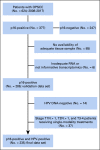Clinical Validity of a Prognostic Gene Expression Cluster-Based Model in Human Papillomavirus-Positive Oropharyngeal Carcinoma
- PMID: 34738049
- PMCID: PMC8563075
- DOI: 10.1200/PO.21.00094
Clinical Validity of a Prognostic Gene Expression Cluster-Based Model in Human Papillomavirus-Positive Oropharyngeal Carcinoma
Abstract
Under common therapeutic regimens, the prognosis of human papillomavirus (HPV)-positive squamous oropharyngeal carcinomas (OPCs) is more favorable than HPV-negative OPCs. However, the prognosis of some tumors is dismal, and validated prognostic factors are missing in clinical practice. The present work aimed to validate the prognostic significance of our published three-cluster model and to compare its prognostic value with those of the 8th edition of the tumor-node-metastasis staging system (TNM8) and published signatures and clustering models.
Methods: Patients with HPV DNA-positive OPCs with locoregionally advanced nonmetastatic disease treated with curative intent (BD2Decide observational study, NCT02832102) were considered as validation cohort. Patients were treated in seven European centers, with expertise in the multidisciplinary management of patients with head and neck cancer. The median follow-up was 46.2 months (95% CI, 41.2 to 50), and data collection was concluded in September 2019. The primary end point of this study was overall survival (OS). Three-clustering models and seven prognostic signatures were compared with our three-cluster model.
Results: The study population consisted of 235 patients. The three-cluster model confirmed its prognostic value. Two-year OS in each cluster was 100% in the low-risk cluster, 96.6% in the intermediate-risk cluster, and 86.3% in the high-risk cluster (P = .00074). For the high-risk cluster, we observed an area under the curve = 0.832 for 2-year OS, significantly outperforming TNM 8th edition (area under the curve = 0.596), and functional and biological differences were identified for each cluster.
Conclusion: The rigorous clinical selection of the cases included in this study confirmed the robustness of our three-cluster model in HPV-positive OPCs. The prognostic value was found to be independent and superior compared with TNM8. The next step includes the translation of the three-cluster model in clinical practice. This could open the way to future exploration of already available therapies in HPV-positive OPCs tailoring de-escalation or intensification according to the three-cluster model.
© 2021 by American Society of Clinical Oncology.
Conflict of interest statement
Loris De Cecco Research Funding: Bristol Myers Squibb Foundation No other potential conflicts of interest were reported. Loris De Cecco Research Funding: Bristol Myers Squibb Foundation No other potential conflicts of interest were reported.
Figures




Similar articles
-
Radical (chemo)radiotherapy in oropharyngeal squamous cell carcinoma: Comparison of TNM 7th and 8th staging systems.Radiother Oncol. 2020 Apr;145:146-153. doi: 10.1016/j.radonc.2019.12.021. Epub 2020 Jan 22. Radiother Oncol. 2020. PMID: 31981964
-
How applicable is the TNM 8 staging for human papillomavirus (HPV) related oropharyngeal squamous cell carcinoma (OPSCC) to a UK population of 106 patients? : A cohort comparison of the TNM 7 and TNM8 staging systems for HPV positive oropharyngeal cancer in a UK population.Eur Arch Otorhinolaryngol. 2021 Mar;278(3):755-761. doi: 10.1007/s00405-020-06143-z. Epub 2020 Jul 3. Eur Arch Otorhinolaryngol. 2021. PMID: 32621245
-
Extracapsular extension of neck nodes and absence of human papillomavirus 16-DNA are predictors of impaired survival in p16-positive oropharyngeal squamous cell carcinoma.Cancer. 2020 Jan 1;126(9):1856-1872. doi: 10.1002/cncr.32667. Epub 2020 Feb 7. Cancer. 2020. PMID: 32032442
-
Human papillomavirus and p16 immunostaining, prevalence and prognosis of squamous carcinoma of unknown primary in the head and neck region.Int J Cancer. 2019 Sep 15;145(6):1465-1474. doi: 10.1002/ijc.32164. Epub 2019 Feb 19. Int J Cancer. 2019. PMID: 30698281
-
Special Issue about Head and Neck Cancers: HPV Positive Cancers.Int J Mol Sci. 2020 May 11;21(9):3388. doi: 10.3390/ijms21093388. Int J Mol Sci. 2020. PMID: 32403287 Free PMC article. Review.
Cited by
-
The Radiosensitivity Index Gene Signature Identifies Distinct Tumor Immune Microenvironment Characteristics Associated With Susceptibility to Radiation Therapy.Int J Radiat Oncol Biol Phys. 2022 Jul 1;113(3):635-647. doi: 10.1016/j.ijrobp.2022.03.006. Epub 2022 Mar 12. Int J Radiat Oncol Biol Phys. 2022. PMID: 35289298 Free PMC article.
-
Hallmarks of a genomically distinct subclass of head and neck cancer.Nat Commun. 2024 Oct 20;15(1):9060. doi: 10.1038/s41467-024-53390-3. Nat Commun. 2024. PMID: 39428388 Free PMC article.
-
HPV-driven cancer: from epidemiology to the HPV-driven tumor board proposal, everything you wanted to know but were afraid to ask.Clin Transl Oncol. 2025 Aug;27(8):3511-3529. doi: 10.1007/s12094-025-03868-3. Epub 2025 Mar 6. Clin Transl Oncol. 2025. PMID: 40048019 Review.
-
Increased Abundances of CD16+ Non-Classical Monocytes Accompany with Elevated Monocytic PD-L1 and CD4+ T Cell Disturbances in Oropharyngeal Cancer.Biomedicines. 2022 Jun 9;10(6):1363. doi: 10.3390/biomedicines10061363. Biomedicines. 2022. PMID: 35740384 Free PMC article.
-
Personalization of Radiotherapy Dose in HPV Positive Oropharynx Cancer Using GARD.medRxiv [Preprint]. 2025 May 2:2023.09.14.23295538. doi: 10.1101/2023.09.14.23295538. medRxiv. 2025. PMID: 37745365 Free PMC article. Preprint.
References
-
- Licitra L, Zigon G, Gatta G, et al. : Human papillomavirus in HNSCC: A European epidemiologic perspective. Hematol Oncol Clin North Am 22:1143-1153, vii–viii, 2008 - PubMed
-
- Syrjänen K, Syrjanen S, Pyrhdnen S: Human papilloma virus (HPV) antigens in lesions of laryngeal squamous cell carcinomas. ORL J Otorhinolaryngol Relat Spec 44:323-334, 1982 - PubMed
-
- Snijders PJF, Cromme FV, van den Brule AJ, et al. : Prevalence and expression of human papillomavirus in tonsillar carcinomas, indicating a possible viral etiology. Int J Cancer 51:845-850, 1992 - PubMed
-
- Gillison ML: Evidence for a causal association between human papillomavirus and a subset of head and neck cancers. J Natl Cancer Inst 92:709-720, 2000 - PubMed
Publication types
MeSH terms
Associated data
LinkOut - more resources
Full Text Sources
Medical
Molecular Biology Databases

